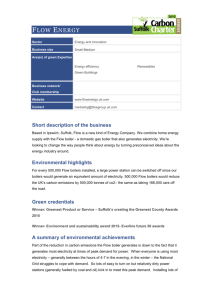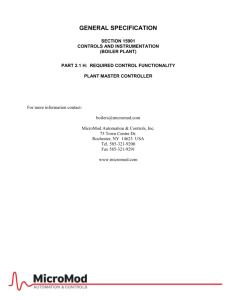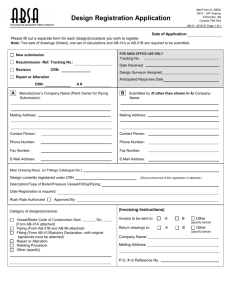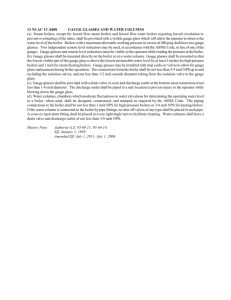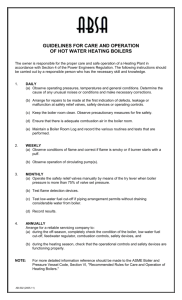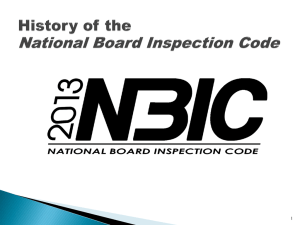State of Oregon boiler class 3 license examination study guide
advertisement
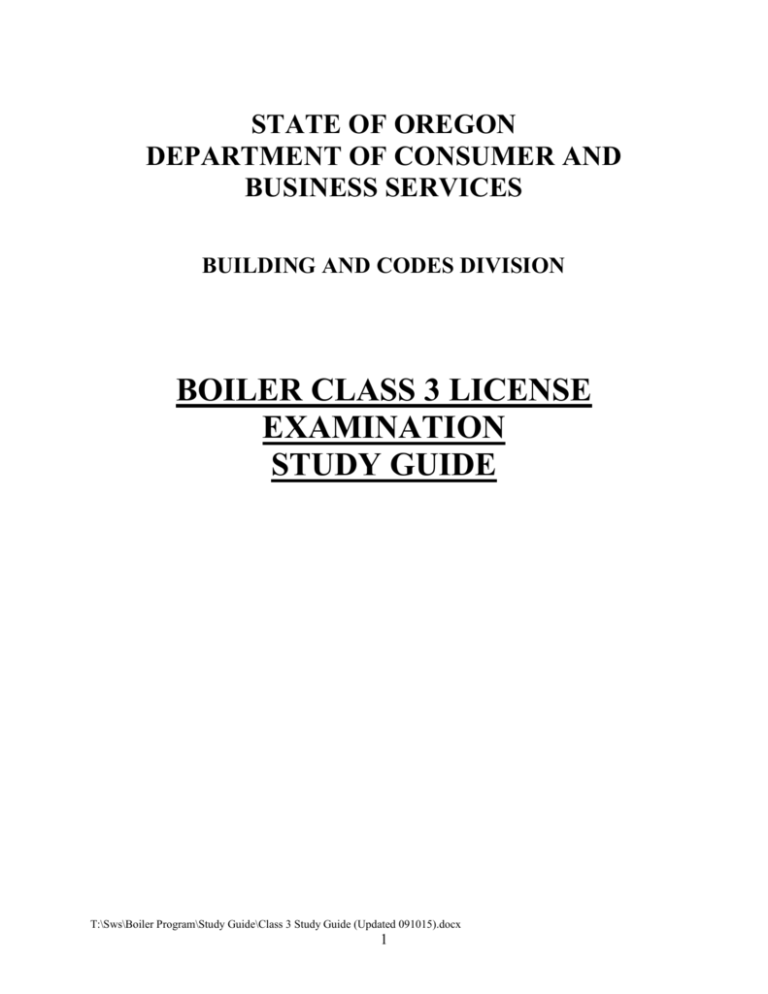
STATE OF OREGON DEPARTMENT OF CONSUMER AND BUSINESS SERVICES BUILDING AND CODES DIVISION BOILER CLASS 3 LICENSE EXAMINATION STUDY GUIDE T:\Sws\Boiler Program\Study Guide\Class 3 Study Guide (Updated 091015).docx 1 General Information for all Licensees The following study guide is to be used to assist you in preparing for the questions on the State of Oregon Boiler Licensing Exams. This is not an extensive listing of knowledge expected from a “Qualified Certified Person.” Where there are general discussions of ASME, NBIC, and NFPA Code requirements or of Oregon Administrative Rules or statutes, the study guide is not controlling: the applicable code, rule or statute is the final authority. The exam questions are randomly selected from a set of over 400 questions that cover administrative rules, ASME, NBIC and NFPA Codes, materials, math, drawing, repairs, physical science, safety, trade knowledge and welding for Class 4 and Class 5 candidates. The exam questions are based upon the knowledge and experience that is expected of candidates for the Class certification being attempted. The rules for licensing of persons installing, altering or repairing boilers or pressure vessels are listed in ORS 480.630 through ORS 480.645. Requirements for each “Qualified Certified Person” who can be licensed to install, alter or repair boilers, pressure vessels and pressure piping in the State of Oregon are listed in OAR 918-225-0691. These consist of Class 2, Class 3, Class 4, Class 5, Class 5-A and Class 5-B. The Class 1 Trainee/Helper and Class 6 Welder are not required to take and pass the Oregon Boiler License Exam to be certified. The exam covers the Oregon Revised Statutes and the Oregon Administrative Rules for boilers and pressure vessels but this study guide does not cover those administrative rules. These administrative rules may be printed off the web site for review and are available on line at: http://www.cbs.state.or.us/external/bcd/programs/boiler.html Boiler Statutes: Oregon Revised Statutes (ORS) 480.510 to 480.670 Boiler Administrative Rules: Oregon Administrative Rules(OAR) 918-225-0220 through 918-225-0800 The 2015 Oregon Boiler and Pressure Vessel Specialty Code containing the minimum safety standards for boilers, pressure vessels, pressure piping, nuclear components, parts, items, and repair and alteration procedures follow: (1) ORS 480.510 to 480.670 and OAR chapter 918, division 225; (2) The Boiler and Pressure Vessel Code of The American Society of Mechanical Engineers (ASME), 2013 Edition as published, including Section I; Section II, Parts A, B,C and D; Section IV; Section V; Section VIII, Division 1, 2 and 3; Section IX; and Section X. (3) The 2012 Edition of the ANSI/ASME B31.1 Power Piping Code. (4) The 2012 Edition of the ANSI/ASME B31.3 Process Piping Code. (5) The 2013 Edition of the ANSI/ASME B31.5 Refrigeration Piping Code. (6)The 2011 Edition of the ANSI/ASME B31.9 Building Service Piping Code. T:\Sws\Boiler Program\Study Guide\Class 3 Study Guide (Updated 091015).docx 2 (7) The 2013 Edition of the National Board Inspection Code (NBIC) ANSI/NB 23; (8) The 2011 Edition of NFPA 85, Boiler and Combustion Systems Hazards Code; and (9) The 2012 Edition of ASME CSD-1, Controls and Safety Devices for Automatically Fired Boilers. The ASME Codes listed above are “codes of construction” and list the allowable design, materials, construction and installation of Code items. The NBIC lists the installation requirements and the permissible repairs to Code items. This study guide will summarize sections of the above codes and discuss trade practices to assist in passing the Boiler license exam. For a more complete understanding of the above Codes, refer to the individual Code sections. Pressure Vessel Installations Piping Attachments Flanged Attachments- The bolts in a flanged connection must exhibit full thread engagement. This means that bolts shall engage so that the threading goes completely through the nut. Follow manufacturers’ recommendations when tightening flange bolts. Threaded fittings- Completed thread fittings must leave at least two threads exposed. In addition, different sized fittings have a minimum number of threads that must be engaged in the fitting. Minimum thread engagement in threaded fittings are as follows: Under 1-1/2” NPS 4 threads 1-1/2” & 2” NPS 5 threads 2-1/2” to 4” NPS 7 threads 5” & 6” NPS 8 threads 8” NPS 10 threads 10” NPS 12 threads 12” NPS 13 threads EXAMPLE: A 2” NPS fitting must have at least 5 threads engaged and must leave at least 2 threads exposed. Piping Materials Piping materials for ASME applications must be listed in ASME Section II. ASME-listed piping materials must have identifying marks recording the piping type, manufacturer and heat numbers of the batch for traceability. When ASME piping materials are cut, the identifying numbers must be transferred to the cut pieces. Since coatings would make the identifying markers unreadable, painting prior to installation or galvanizing is not allowed. Some non-metallic piping, including plastic piping, is listed in ASME Section II and is allowed in ASME B31.9, Building Service Piping, but the use of PVC plastic pipe is not allowed. PVC piping may not be used because it may fracture under pressure and will become brittle when cold. In air compressors, PVC could be affected by compressor oils in the air stream. T:\Sws\Boiler Program\Study Guide\Class 3 Study Guide (Updated 091015).docx 3 ASME B31.9, Building Service Piping covers piping systems operated at pressures up to 150 psi. Used pipingUsed piping and piping fittings may only be used after thorough cleaning and inspection by an authorized inspector. If identifying marks are not clearly visible, the inspector may require mechanical and/or chemical testing to verify the composition of the material. Pressure testing of vessels and piping systemsLeak testing of pressure vessels and piping systems may be required by an inspector. The To safely pressurize a system for a leak test: the system’s pressure must be gradually increased to a required test pressure (provided by the inspector) the test pressure must be maintained for a designated period of time, generally between 10 to 20 minutes. If water is used to perform the leak test, the metal temperature must be at least 60oF to assure the vessel is not thermally stressed. For personnel safety, the temperature should not exceed 120oF. If air or nitrogen is used to perform the leak test, the test will be performed at lower pressures and must first be approved by an inspector. Air and nitrogen under pressure have high kinetic energy and could create an explosion if there is a rupture. Piping weight and hydrotestsWhen installing piping, the additional weight that will be applied during a hydrotest must be taken into consideration. Even air piping must be installed so that it can bear the weight that will be applied during a hydrotest. Thus, an installer must know the weight of the entire piping system in order to properly design and select pipe supports and hangers. To know the weight of a section of pipe that is filled with water, you must know: The weight of the pipe per foot of run The volume inside the pipe The weight of the water required to fill that volume Figuring out this information sometimes requires the use of basic math and the memorization of some basic facts about the weight of water and the volume of water within an area. Mathematical terms related to circles: Circumference Diameter Radius T:\Sws\Boiler Program\Study Guide\Class 3 Study Guide (Updated 091015).docx 4 For the purposes of using math in the field, (pi) is rounded off to be 3.14 You should also know how to convert fractions into decimals: To convert ¾ into a decimal, divide 3 by 4, which would give you .75 You can use a calculator to do this, or you could do it long hand by adding a decimal point and zero to the top half of the fraction (dividing 3.0 by 4) and putting your answer to the right of the decimal point your answer. ½ = .50 [1.02 = .50] 1/3 = .333 [1.0 3 = .333] 4/5 =.80 [4.0 5 = .80] 7/8 = .875 [7.0 8 = .875] Area of a circle The formula for calculating the area of a circle is: Radius x Radius x 3.14 = Area ( r2= Area) Example- For a 6 inch diameter pipe, the radius equals one half of the diameter, 3 inches 3 inches x 3 inches x 3.14= 28.3 square inches Circumference of a circle The formula for calculating the circumference of a circle is: Diameter x 3.14= Circumference (d=Circumference) Example- For a 6 inch diameter pipe, 6 inches x 3.14= 18.84 inches in circumference Also, with pipes there are two circumferences: the inner circumference (the circle that is on the inside of the pipe) the outer circumference (the circle that is on the outside of the pipe) As pipes get larger there can be a substantial difference between the inner circumference and the outer circumference. To calculate the inner circumference you would use the diameter of the inside of the pipe. To calculate the outer circumference, your diameter would be the diameter from the inside of the pipe plus the thickness of the pipe. Example- The outer circumference of a ½” thick pipe with a 6 inch inner diameter would be: 7 inches (6” inner diameter plus ½” thickness on both sides) x 3.14= 21.98 inches 2 T:\Sws\Boiler Program\Study Guide\Class 3 Study Guide (Updated 091015).docx 5 Volume of a cylinder (or pipe) The formula for calculating the volume of a cylinder is: Area x Length = Volume Example- For a 6 inch pipe with a 24 inch run (length): 28.3 inches x 24 inches = 679.2 cubic inches of volume Calculating gallons of water per cubic inch The formula for knowing how much water is in a volume of pipe is: One gallon of water = 231 cubic inches of piping We know from the previous calculations that a 6 inch pipe that runs 24 inches pipe holds 679.2 cubic inches of water volume. 679.2 (volume in cubic inches) 231 (# of cubic inches in a gallon) = 2.94 gallons Weight of water The formula for the weight per gallon of water is: One gallon of water weighs 8.34 pounds Since our 6 inch pipe that runs 24 inches holds 2.94 gallons of water we can determine the weight of the water as follows: 2.94 gallons x 8.34 pounds = 24.5 pounds of water Pressure of water The formula to determine the pressure of water at the bottom of a column of water (for example, the bottom of a pipe or tank) is: Height of the column in feet x .434 = pressure per square inch (PSI) Example- The pressure for a 40 foot high column of water is: 40 x .434 = 17.36psi Boiling point of water and other substances The boiling point of a liquid is the temperature at which the vapor pressure of the liquid equals the environmental pressure surrounding the liquid. A liquid in a vacuum environment has a lower boiling point than when the liquid is at atmospheric pressure. A liquid in a high pressure environment has a higher boiling point than when the liquid is at atmospheric pressure. T:\Sws\Boiler Program\Study Guide\Class 3 Study Guide (Updated 091015).docx 6 In other words, the boiling point of liquids varies with and depends upon the surrounding environmental pressure. The normal boiling point of a liquid is the special case in which the vapor pressure of the liquid equals the defined atmospheric pressure at sea level. Example- The normal boiling point of water is 100C/212F Heat Capacity Specific heat capacity is the measure of the heat energy required to increase the temperature of a unit of a substance by a certain temperature. More heat energy is required to increase the temperature of a substance with high specific heat capacity than one with low specific heat capacity. The term "BTU" is used to describe the heat value (energy content) of fuels, and also to describe the power of boilers, as well as heating and cooling systems. When used as a unit of power, BTU 'per hour' is understood, though this is often confusingly abbreviated to just "BTU". 1 watt is approximately 3.413 BTU/h 1000 BTU/h is approximately 293 W 1 horsepower is approximately 2,544 BTU/h A BTU is also the energy required to raise one pound of water by one degree Fahrenheit. Design Pressure All pressure containing components must be rated at a design pressure at least as high as the vessel design pressure. Piping components such as flanges and valves are typically marked with the design pressure. Valves ASME approved safety relief valves are required for every vessel Shut off valves are not permitted on either the inlet or discharge of safety relief valves The piping on the discharge side of a safety relief valve may not be reduced down nor routed such that the flow could be restricted by pocketing that traps liquid. The discharge from the safety relief valve must be directed to a safe location. Safety relief valves must be handled carefully so as to not disturb their setting If the safety relief valve’s assembly seal is not intact, the valve must be retested and recertified or the unit must be replaced. Safety relief valves can only be disassembled and set by a NBIC authorized Service Center. Valves should be positive shut off. Positive shut off valves include gate valves, ball valves, tapered cock valves and globe valves. Globe valves are directional and should be installed with the flow direction below the disc. Valves should be clearly marked as suitable for the service. For example, a water, oil gas service valve should be marked: “W-O-G” for water, oil and gas. T:\Sws\Boiler Program\Study Guide\Class 3 Study Guide (Updated 091015).docx 7 Workplace Safety Pipe fitters and boilermakers are commonly exposed to potential safety hazards. General Safety Precautions When working on oxygen piping or oxygen generators, care should be taken to eliminate organic materials as these can combust when exposed to the oxygen. A simple oily rag exposed to oxygen can ignite. Oxygen storage tanks must be installed on a non oxidizing surface. Confined areas, like service pits or the inside of a boiler or pressure vessel, can lack sufficient oxygen for safe breathing. Before entering such a space: Make sure an OSHA approved confined space entry procedure is being followed. (Oxygen levels must be tested, there must be adequate ventilation, and the temperature must not be too high). Where welding is taking place there must be a trained person watching for fire and able to perform rescues and emergency medical treatment. Fires and explosions are one big risk in the work site. In order to deal with this risk safety precautions should always be followed and individuals need to know how to properly use fire extinguishers. Fire extinguishers are marked with the class of fire they are designed to be used upon: Class A Class B Class C Class D Wood, sawdust, paper, rags Flammable liquids, oils, tars and gasses Electrical equipment Combustible, self-oxidizing metals Water hoses should only be used on Class A fires. Water can cause explosions or a worsening of the fire if it is used on a Class B, C, or D fire. Foam, CO2 and dry powder extinguishers eliminate the oxygen from different types of fires, the following types of extinguishers are suited to the following type of fire: Class A fires, water or CO2 extinguishers Class B fires, CO2 or foam extinguishers Class C fires, CO2 extinguishers or dry chemical extinguishers must be used if there is live current Class D fires, different metals require different extinguishing materials, thus the work site should have dry powder extinguishers that are appropriate for the potential fire dangers T:\Sws\Boiler Program\Study Guide\Class 3 Study Guide (Updated 091015).docx 8 Blueprints Blueprints are generally drawn through isometric projection. Isometric projection is a mathematical method of constructing a 3 dimensional object without using perspective. Isometric projection was an attempt to make drawings more realistic. The mathematics involved mean that all lengths when drawn at 30 degrees can be drawn using their true length (in other words lines aren't shortened as with oblique drawings). An isometric drawing shows two sides of the object and the top or bottom of the object. All vertical lines are drawn vertically, but all horizontal lines are drawn at 30 degrees to the horizontal. Isometric is an easy method of constructing a reasonable '3 dimensional' images. The term isometric comes from the Greek for "equal measure", reflecting that the scale along each axis of the projection is the same (this is not true of some other forms of graphical projection). Class 3 License Requirements Class 3 Building Service Mechanic License. A person holding this license may install or repair boilers (including boiler and non-boiler external piping) and unfired pressure vessels by a nonwelded method of attachment. Class 3 licensees are required to take 24 hours of continuing education during each 3-year licensing cycle. Applicants shall: 1. Have at least 2,000 hours of experience installing and repairing boilers verified as established in OAR division 30; 2. Pass an examination testing the applicant's knowledge of: (A) Boiler and Pressure Vessel Laws, ORS 480.510 to 480.665; OAR chapter 918, division 225; and the general requirements of the American Society of Mechanical Engineers, Boiler and Pressure Vessel Code, Sections I, IV, and VIII, and CSD-1; (B) The State of Oregon Boiler Safety Program Study Guide; (C) Building Service Systems (Hydronics) for boilers and related appurtenances, American Society of Mechanical Engineers/ASME B31.1 Power Piping and B31.9 Building Service Piping; and (D) Structural and mechanical blueprints with the ability to interpret specifications. T:\Sws\Boiler Program\Study Guide\Class 3 Study Guide (Updated 091015).docx 9 Boiler Installation Requirements ASME stamps All boilers and pressure vessels shall be installed to comply with the Oregon State Boiler and Pressure Vessel Law and must be ASME Code Stamped (unless installed to an approved International standard): Section I power boilers shall be stamped with a A, M, E, or “S” code stamp. Section IV hot water heating boilers and hot water supply boilers shall be stamped with an “H” or “HLW” code stamp. Unfired pressure vessels shall be stamped with a “U” or “UM” code stamp. Welded boiler external piping over NSP 2”, if installed by other than the boiler manufacturer, must be stamped with a “S” or “PP” code stamp. Notifying Authorized Inspector before Work Begins All installation/repair permits issued by the State of Oregon Building Codes Division require that the authorized inspector be notified prior to commencement of work. It is imperative that the inspector is contacted as some installations and most repairs require inspections before much progress is made on a project. Work done prior to the approval of the inspector may have to be removed and re-done. Controls and Safety Devices for Automatically Fired Boilers (CSD-1) ASME CSD-1, Controls and Safety Devices for Automatically Fired Boilers applies to all boilers under 12,500,000 BTU. National Fire Protection Association (NFPA) requirements apply to boilers 12,500,000 Btu and over. Control devices are required to be tested and certified by the Underwriters Laboratory (UL). Rebuilt and repaired devices are not allowed as their certification is no longer valid. All electrical components shall be mounted in the appropriate National Electrical Manufacturers Association (NEMA) enclosures. All wiring for boilers shall be rated for the maximum temperature to which they may be exposed. Boiler Clearances Installation of boilers in newly constructed boiler rooms shall have: A minimum side clearance of 36 in. on each side and adequate room to all for removal and installation of boiler tubes. The top clearance must be at least 36 in., unless there is a top manway where a top clearance of 84 in. is required. Boilers with bottom openings shall have at least 12 in. bottom clearance. Boilers in battery (connected to each other) shall have a minimum of 48” clearance between the boilers. T:\Sws\Boiler Program\Study Guide\Class 3 Study Guide (Updated 091015).docx 10 Boiler Room Exits Boiler rooms shall provide two means of exit when the boiler room exceeds 500 sq. ft. and the boilers have a capacity of 1,000,000 Btu/hr or greater. Multiple Boiler Installations For multiple boiler installations: Steam boilers shall all be installed such that all boilers have the same low water operation level. High pressure steam outlet stop valves used where the boilers have man-ways and a common header require two outside screw and yoke rising stem block valves. A stop valve shall be installed in each supply and return connection for each boiler. For high pressure steam boilers with man-ways connected to a common header, the boiler external piping ends at the second block valve. Diligence must be exercised to assure that the boiler you are working is locked out and tagged out. Each boiler shall have temperature, pressure and level limit controllers and not rely on safety controllers that are located on a common header. Steam boilers operated in battery shall not be installed closer than 48 inches from each other. CSD-1 The operation of control systems and safety devices installed as required by CSD-1 shall be tested by the installing contractor prior to release to the owner/user. Installing contractors shall provide a written report for each installation that shall list: 1) each control and safety device installed in accordance with CSD-1 2) name of the manufacturer and model number of each device 3) operational tests performed The above items shall be verified by signature of an authorized representative of the installing contractor on this report. This report shall be made available to the authorized inspector prior to final inspection. The installing contractor shall provide to the owner/user pertinent operating, testing, servicing and cleaning instructions for the controls and safety devices together with complete wiring and piping diagrams and a written precaution that operating, testing and servicing may only be performed by qualified individuals. Valves in General All valves or cocks shall have adjustable stem packing glands and provide tight closure. Valves shall indicate when open by either a lever in cock valves or a rising stem for gate valves. T:\Sws\Boiler Program\Study Guide\Class 3 Study Guide (Updated 091015).docx 11 No shut off or other valves are to be placed between the boiler and the pressure controllers, nor should valves be placed on the discharge side of a pressure relieving valve. Discharge piping must be directed to a safe location and the weight of that discharge piping cannot be supported on a valve, as this could cause distortion of the valve mechanism and affect the performance of the valve. The purpose of stop check valves on the main boiler steam discharge line to a steam header for multiple boilers is to prevent steam from entering a cold boiler. Cold water should never be introduced into a hot boiler. Feedwater piping should be located such that the addition of water is not onto a hot boiler surface. “Water hammer” is a pressure surge or wave resulting when a fluid in motion is forced to stop or suddenly change direction. Water hammer commonly occurs when a valve is closed suddenly at an end of a piping system, and a pressure wave develops in the pipe. Water hammer in piping or a vessel can cause a rupture. The hammering sound heard is the result of liquid water traveling ahead of expanding steam. The pressure wave can exceed the safe allowable pressure in the pipe or vessel. Pressure Relieving Valves Pressure relieving valves are generally spring controlled valves that pop open at a preset pressure to assure that the vessel cannot over-pressurize. Any pressure relieving device used on an ASME boiler or pressure vessel must be marked with an ASME “V”, “HV” or “UV” code stamping. Section I power boilers that exceed 500 sq. ft. of heating surface must have 2 or more safety valves. The valves shall be sized such that the relieving capacity will not allow the pressure of the boiler to exceed 106% of the maximum allowable working pressure (MAWP). Example: A 750 square foot boiler with a MAWP of 150 pounds per square inch would require 2 safety valves. The two valves, in combination, could not allow the boiler to exceed 159 psi (106% of the MAWP) An electric boiler with a power input of more than 1100 kW must have 2 or more safety valves. The valves shall be sized such that the relieving capacity will not allow the pressure of the boiler to exceed 106% of the maximum allowable working pressure (MAWP) Example: A 750 square foot boiler with a MAWP of 150 pounds per square inch would require 2 safety valves. The two valves, in combination, could not allow the boiler to exceed 159 psi (106% of the MAWP) Section IV steam boilers cannot have individual safety valves that are larger than 4” NPS (4” nominal pipe size) T:\Sws\Boiler Program\Study Guide\Class 3 Study Guide (Updated 091015).docx 12 Steam boilers must use a safety valve that is designed for steam only Section IV heating boilers cannot have individual safety valves that are larger than 4” NPS. Section IV boiler valves shall be made of ASME Code Section II approved materials or an ASME Code accepted standard, such as ANSI. The minimum pressure/temperature rating shall at least equal the pressure limits stamped on the boiler and equal to the boiler design temperature but not less than 250oF. Hot water boilers must have a relief valve designed for water use. The safety relief valve shall be set to relieve at or below the MAWP of the boiler Section VIII pressure vessels use a valve with an enclosed spring that is designed for either liquid or gas applications. Air is a gas. All spring controlled pressure relieving valves must be mounted with the valve stem in a vertical position, close to the vessel (for boilers the device must be mounted directly to the boiler) Steam boilers must have the safety valves located at the top of the boiler and above the normal high water operation level Steam boilers shall have at least one steam pressure control device that will shut off the fuel supply when the steam pressure reaches a preset operating pressure. An additional pressure controller is required that will prevent generation of steam pressure that exceeds the MAWP of the boiler. This high limit pressure controller shall have a safety shutdown and lockout with a manual reset. Steam boilers also require a siphon tube or other means that maintains a water seal between the boiler and the pressure controllers. Residential installations do not require the lockout feature on the high limit pressure controller. Steam supply connections to a pressure control shall not be less than the following: Non-ferrous materials NPS ¼” up to 5 ft. length NPS ½” over 5 ft. length Ferrous materials NPS ½” up to 5 ft. length o NPS 1” over 5 ft. length Temperature and Pressure Safety Valves Hot water service vessels with a temperature limit of 210oF, such as HLW hot water storage tanks, some coil type boilers and hot water heaters shall utilize a temperature and pressure safety valve (T&P). T:\Sws\Boiler Program\Study Guide\Class 3 Study Guide (Updated 091015).docx 13 T & Ps have a bi-metallic probe that opens the valve prior to the boiling point of water. T & Ps may be mounted in a horizontal position but must be located such that the probe is always immersed in water at the normal operating liquid level and the outlet pointed down. The horizontal mounting cannot be lower than 4” from the top of the vessel and cannot have more than 4” of interconnecting piping. The discharge must be self draining. Gages All boilers shall have a shut off cock between the boiler and a gage with a lever handle that is parallel with the supply line to the gage when the cock is open Section I steam boilers shall: Have a pressure gage that reads approximately double the relief setting of the safety relief valve and never less than 1 ½ times the relief safety setting. Have a siphon tube that maintains a water seal between the boiler and the gage. The minimum size for the siphon if used shall be ¼” inside diameter. Have connections to the boiler, except the siphon, that are not less than ¼” NPS, but where steel or wrought iron pipe or tube is used, they shall not be less than ½” inside diameter. Section IV hot water heating and hot water supply boilers require a temperature gage or thermometer located in the liquid portion of the boiler near or at the outlet of the boiler. Section I and Section IV steam boilers require water level indicators. Section I boilers must have a visible gage that is mounted with the lowest visible water level at least 2” above the lowest permissible water level. Section IV steam boilers must have a visible gage that is mounted with the lowest visible water level at least 1” above the lowest permissible water level. Multiple gage glasses must have a 1” overlap in visible water level. Connections to and from the water column must be a minimum NPS 1 with the boiler connections having the upper connection in the steam section of the boiler and the lower in the water section. The drain on the water column must be at least NPS ¾. Gage glass connections must be at least NPS ½. A cross or tee pipe fitting shall be used at 90o turns to facilitate cleaning. Water Level Controls Water level controls vary with the type of boiler. Commercial installations of steam boilers require two low water fuel cutoffs. o One cutoff is mounted to actuate before the other cutoff o The lower cutoff unit must actuate prior to loss of visible water in the sight glass o The lower cutoff must shut down the energy to the burner AND lock out as well. There is to be a manual reset on the locking out unit. o The units on steam boilers must be located on separate water columns with no intervening valves and separate attachments to the boilers water section. There may be a common steam section attachment. T:\Sws\Boiler Program\Study Guide\Class 3 Study Guide (Updated 091015).docx 14 o Cross or tee pipe fittings shall be used at 90o turns to facilitate cleaning. o Controls should be cleaned annually. Coil type hot water heating boilers that require forced circulation shall have a flow sensing switch that will prevent operation of the burner when there is an inadequate flow rate. The flow switch shall have a testing circuit that will automatically restore to service after testing is complete. Hot water heating boilers shall have a temperature actuating control to shut off the fuel supply when the water reached a preset operating temperature. A second temperature control is required to limit the water temperature to the maximum allowable temperature; the upper set point adjustment must be fixed at the maximum allowable temperature. This control shall cause a shut down and lockout of the boiler. The lockout feature on the high limit device is not required on residential installations. Pressure testing boilers depends upon the type of boiler. Most types of boilers are to be hydro tested by filling the boiler with water that is at least 60oF and gradually increasing the pressure to 1-1/2 times the MAWP of the boiler. The boiler temperature should not exceed 120oF. The pressure shall be measured by a certified gage that has a measuring range of about double the test pressure but in no case less than 1 ½ times the test pressure. Drains and Bottom Blow Down Pipes Section IV low pressure boiler drains for steam or hot water boilers shall: Be a minimum of ¾” NPS Have a valve that is pressure rated at least equal to the MAWP of the boiler, but in no case less than 30 PSI. The valve must have a minimum temperature rating of no less than 250F Drain piping must be located at the lowest point of the boiler shell. Cast iron boilers are required to have a wash out opening that is NPS 1-1/2 for boilers with a volume more than 5 ft3 or NPS 1 for boilers not more than 5 ft3. Damaged cast iron boiler sections are not allowed to be brazed, welded or epoxy repaired. Code welding cannot be done on metals that have over 0.35% carbon. Cracked or eroded sections can only be replaced with a new section. Cast aluminum boilers are required to have a wash out opening that is NPS 1-1/2 for boilers with a volume more than 5 ft3, NPS 1 for boilers from 2 ft3 to not more than 5 ft3 or NPS ¾ for boilers less than 2 ft3. Section I steam boiler bottom blow down pipe fitting within the boiler external boundary shall: Be made of steel The pipe thickness shall not be less than that of a schedule 80 pipe for boilers with a maximum working pressure exceeding 100 PSI Galvanized steel pipe and fittings shall not be used for blow down pipe. T:\Sws\Boiler Program\Study Guide\Class 3 Study Guide (Updated 091015).docx 15 Section I steam boilers with a working pressure of more than 100 PSI shall have two slow opening valves or one quick opening valve at the boiler nozzle followed by a showopening valve. Minimum size of bottom blow-off piping and valves are: 1. Square feet of heating area for Section I “S” Stamped boilers up to 20 Minimum NPS ½” over 20 to100 Minimum NPS ¾” above 100 Minimum NPS 1” Maximum size of blow down pipe is 2 ½” 2. Steam capacity in lbs per hr for Section IV “H” Stamped boilers up to 500 NPS ¾” 501 to 1250 NPS 1” 1251 to 2500 NPS 1-1/4” 2501 to 6000 NPS 1 ½” Above 6000 NPS 2” Disconnects CSD-1, CE-100 requires an electrical switch to disconnect all power to the burner controls. o This disconnect must be capable of being locked in the open position and be located on or adjacent to the boiler. o The disconnect shall remove all electrical sources of potential. Boiler installations also require a manually operated remote shut down switch outside each entry door to the boiler room. o If a boiler room door opens to the outside of the building, the switch shall be just inside the door. o Manually operated remote shut down switches shall be marked for easy identification. Vents Combustion air shall be adequate for the design of the boiler. Should vents be equipped with louvers or fans to supply combustion air, the louvers or fans must be interlocked with the burner so that flow is proven during burner operation. Boilers firing LP gas that do not comply with ANSI Z21.13 which are installed indoors, shall be equipped with safety shutoff devices or the complete shutoff type that will shut off the flow of gas to both the main burner(s) and pilot(s) in the event of a flame, pilot or ignition failure. T:\Sws\Boiler Program\Study Guide\Class 3 Study Guide (Updated 091015).docx 16 Boilers having an input rating of 400,000 but/hr or less, with field installed gas burner assemblies and boiler units that do not comply with ANSI Z21.13/CSA 4.9 shall comply with the provisions for purging, safety control timing, action on flame failure, loss of combustion air, combustion air proving and fuel supervision given in ASME CSD-1 Table CF-1 or Table CF-2, as applicable. Gas fired boilers in excess or 400,000 btu/hr input shall meet all of the requirements of CSD-1 (Combustion Side Control) part of CF: Required lines must be vented to atmosphere shall not be connected to a common manifold and must run full size to a point of safe discharge. The terminal point shall be provided with means to prevent stoppage by foreign material, moisture or insects. Supply line manually operated shut off valves for NPS 2” and larger, the valves shall be lubricated plug type with stops and the handle shall indicate clearly the “on” and “off” positions. Pilot piping shall have a similar shut off valve. For purge, post-purge, flame failure, proving and start times see ASME CSD-1, Table, CF-1, Table CF-2, Table CF-3, and Table CF-4. Oil fired boiler burners that have an input rating greater than 3 gph require: A UL 296 or a UL 726 label Supply line filters and strainers located upstream of the safety shutoff valve A pressure relief valve connected to a fuel supply line in which pressure greater than the design pressure can build up by closing any valve. The relief discharge shall be routed to the oil tank or the pump suction. For burners (except rotary cup), unless the oil pump is integral with the burners motor shaft and operates over 20 gpm, the main burner shall have a low pressure interlock switch that will cause a safety shutdown if the oil pressure falls below the manufacturers design pressure Burners with a low pressure interlock switch that will cause a safety shutdown if the atomizing air of steam falls below the manufacturer’s design pressure For preheated oil system, burners shall have a high oil temperature interlock switch that will cause a safety shutdown and lockout when the oil temperature exceeds preset limits. An interlock switch to cause safety shutdown for low temperature oils that allows circulation to reestablish preset oil temperature Two approved safety shut off valves or one safety shutoff valve and a nozzle cutoff valve integral to the fuel unit shall be provided. The safety shutoff valves shall conform to the Standard for Electrically Operated Valves, UL 429. A nozzle cutoff valve shall conform to the Standard for Pumps for Oil Burning appliances, UL 343. Safety shutdowns and lockouts established upon loss of combustion air for boilers rated greater than 20 gpm. For boilers rated less than or equal to 20 gpm, where T:\Sws\Boiler Program\Study Guide\Class 3 Study Guide (Updated 091015).docx 17 the forced or induced draft fans are not integral with the motor shaft, loss of combustion air shall shut off the burner. That each main burner assembly shall provide a primary safety control that will de-energize fuel supply upon flame loss. The primary safety control shall require manual resetting even in the event of a power loss. For purge, post-purge, flame failure, proving and start times see ASME CSD-1 and Table CF-5 Electrically heated boilers for steam or hot water service greater than 115 kW shall comply with Standard for Electric Boilers UL 834, NEC and NFPA 70. Boiler units having inputs greater than 2,500,000 Btu/hr (gas fired) or 20 gph (oil fired) shall be equipped with an interlocked damper to provide for low fire starts. Expansion Tanks Hot water heating boilers shall have an expansion tank consistent with the capacity of the system. For systems designed for a working pressure of 30 psi, the expansion tank shall be designed for a minimum hydrostatic test of 75 psi. Expansion tanks for systems designed to operate above 30 psi, the tank shall be designed in accordance with ASME Section VIII, Division 1. Provisions shall be made for draining the tank without emptying the system, except for pre-pressurized tanks. “H” Stamped Boiler Expansion Tank Capacities System Volume Tank Capacities (Gallons) Gallons 100 200 300 400 500 1000 2000 Pressurized Diaphragm Type 9 17 25 33 42 83 165 Non-pressurized Type 15 30 45 60 75 150 300 System vol. includes boiler, radiation and piping, not expansion tank. Above expansion tank capacities based upon 195oF, fill pressure 12 psi and 30 psi operating pressure . “HLW” Stamped Boiler Expansion Tank Capacities System Volume Tank Capacities (Gallons) T:\Sws\Boiler Program\Study Guide\Class 3 Study Guide (Updated 091015).docx 18 Gallons 50 100 200 300 400 500 1000 2000 Pressurized Diaphragm Type 1 2 3 4 5 6 12 24 Non-pressurized Type 3 6 12 18 24 30 60 120 System volume includes boiler, radiation and piping, not expansion tank. Above expansion tank capacities based upon 180oF, fill press 60 psi and 125 psi operating pressure . T:\Sws\Boiler Program\Study Guide\Class 3 Study Guide (Updated 091015).docx 19 T:\Sws\Boiler Program\Study Guide\Class 3 Study Guide (Updated 091015).docx 20 T:\Sws\Boiler Program\Study Guide\Class 3 Study Guide (Updated 091015).docx 21 T:\Sws\Boiler Program\Study Guide\Class 3 Study Guide (Updated 091015).docx 22 T:\Sws\Boiler Program\Study Guide\Class 3 Study Guide (Updated 091015).docx 23 T:\Sws\Boiler Program\Study Guide\Class 3 Study Guide (Updated 091015).docx 24 T:\Sws\Boiler Program\Study Guide\Class 3 Study Guide (Updated 091015).docx 25 T:\Sws\Boiler Program\Study Guide\Class 3 Study Guide (Updated 091015).docx 26 T:\Sws\Boiler Program\Study Guide\Class 3 Study Guide (Updated 091015).docx 27 T:\Sws\Boiler Program\Study Guide\Class 3 Study Guide (Updated 091015).docx 28 T:\Sws\Boiler Program\Study Guide\Class 3 Study Guide (Updated 091015).docx 29 T:\Sws\Boiler Program\Study Guide\Class 3 Study Guide (Updated 091015).docx 30

